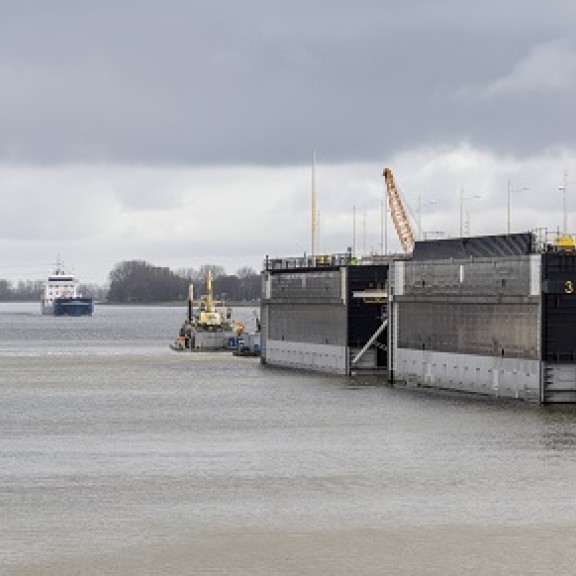
All the lock gates have been put into position
In March 2021, the last two lock gates on the canal side were successfully installed. The whole operation lasted four days. Edgar Breedveld and Victor Arnolds were involved in this milestone achievement. They directed the positioning process and ensured a good outcome.
They told us about their work and about the positioning process.
Manoeuvring the lock gates into position
The lock gates were towed from Amsterdam to IJmuiden by tugboats. Upon arrival, the lock gates were manoeuvred into the lock and moored there. Victor explained, “After that, the lock gates were installed with the help of winches and tugboats. A winch is a tool with a steel wire that can be used to lift or pull heavy objects. First, the winches were connected to the lock gate. After this, the lock gate was pulled towards the lock gate chamber. With the help of the tugboats, the gate was put into position. When the lock gate was in position, it was sunk by filling the special ballast tanks of the ballast system with water. Once the lock gate was at the correct depth in the inner head gate chamber, the gate itself was connected to the upper and lower wheel carriages.”
One lock gate in the dry dock
Victor explained, “In the same way as the inner gate was brought into the gate chamber, the spare lock gate was positioned into the dry dock next to it. The gate of this dry dock was closed on 13 April. If, in the future, one of the gates requires maintenance, the dry dock can provide easy access to it. The water can be pumped out of the dry dock to allow maintenance work being carried out to the spare gate.”
A tight schedule
The installation of the gates went well. Good preparation proved to be essential. Victor made checklists in advance, which were completed during the final preparations. The whole operation depended on the weather, the personnel and the equipment. Edgar added, “The last days before the scheduled positioning of the gates were hectic. The first series of weather forecasts were not so good, as the wind speeds were above the safety criteria. So we met every day to look at the weather forecast. In the end, the forecasts improved and 72 hours before the operations were programmed, we decided to go ahead with it.” On the day itself, a tight timetable was maintained. Victor explained, “We started the day with a kick-off meeting. In this meeting, we went over everything, such as the weather conditions, personnel involved, available facilities and a thorough check if everyone and everything was complete and ready for action. Then we wished everyone a good day and got to work.”
Points of attention during the positioning of the gates
The main focus for Victor and Edgar was safety for all. Edgar added, “We also had to keep an eye on our own safety because, as the saying goes: ‘out together, home together’.” The operation was successfully completed. Victor explained, “We had planned four days of work for the two lock gates. The first lock gate took 11 hours, the other one 10 hours, so everything went faster than expected. The positioning of the gates into the gate chamber was a daylight operation and the daylight determined when we had to start and stop. Edgar and Victor also had to take the shipping traffic into account. It appeared that ships were hardly affected by the operation. Edgar explained, “During the preliminary stages and the operation itself we kept Port of Amsterdam informed as accurately as possible. We also had applied for all transport permits for the lock gates well in advance. It so happened that there was a lock closure planned for the period of the positioning of the gates, so we had the North Sea Canal almost to ourselves. During the positioning of the gates in the gate chamber, we noticed small water movements due to ships passing the area, but it was not necessary to limit shipping traffic. As the positioning took place mainly in the lock and lock gate chamber itself, any inconvenience by water movements was limited.”
Now that all the lock gates are in position, a new testing period can begin.